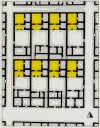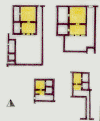| |
Priene: The
Apogee of the Hellenisctic Domestic Architecture in Anatolia
Lale Ozgenel, Instructor
Middle East
Technical University
Department of Architecture / History of Architecture


Western coast of Anatolia was the
homeland of the Ionian Greeks who had left numerous architectural
monuments. The remains of temples, theaters, gymnasia, agoras, and
fountains that once adorned the prosperous Ionic cities, are visible
in various sites today. These urban edifices attest not only the
wealth of the ancient cities but also the prominence given to urban
life and quality. Yet, little is known about the private life of the
inhabitants who erected these landmarks. The gap is partly due to
the lack of the literary evidence and partly due to the extent of
the archaeological survey. The remains of domestic architecture and
residential patterns in Anatolia have rarely been thoroughly
excavated and integrated into the urban fabric (1). However, an
exceptional site is Priene where a large portion of the residential
pattern has been excavated. The excavations yielded significant
information both about the lifestyles of the inhabitants and also
the spatial organization and the quality of the Hellenistic houses
in Anatolia. In addition, Priene until now is the only thoroughly
excavated site in Ionia and provides a huge body of archaeological
evidence that can be used for comparative studies for the domestic
architecture found in the other well known sites outside Anatolia.
In this sense, Priene contributed much to the studies on the
domestic architecture in antiquity like Olynthus in mainland Greece
and the island of Delos in Aegean did (2). Therefore, Priene
deserves a special emphasis. Hellenistic period (third century
BC-first century BC) was a period of prosperity and peace in
Anatolia. It was a renaissance of the antique world distinguished
with scientific experimentation, intellectual progress and
refinement and plasticity in art (3). In terms of city-planning and
architecture as well, more progressive, revolutionary and refined
designs changed the urban quality of many classical cities
exemplified best perhaps by Miletus and Pergamon. In terms of
domestic architecture, the Hellenistic mannerism is best reflected
in Priene. Quennel (1957) The layout of the Hellenistic Priene dates
back to 350 BC though it is known that the site was founded much
earlier in the archaic period (4). The town had a single harbor that
did not play an active role in the Ionian trade. The settlement then
was a moderate sized town, mainly agricultural with little trade.
The ruins of Priene visible today belong to the fourth century BC
and later. The plan of the city was arranged according to the
Hippodamian grid even though the topography was inconvenient for
such a geometric layout. The well-preserved buildings and streets
provide an opportunity to obtain detailed information both about the
actual settlement forms and the life in the city. In the plan the
main streets are arranged on the east-west axis while the secondary
ones, in the form of steps, cross these on the north-south axis. All
the buildings were organized in blocks of equal size, 47.2 m x 35.4
m (5). In general, each block consisted of four houses. The width of
the main streets is generally 4.44 m while the others is about 3.5 m
The main street passing in front of the stoa however, is as wide as
7.36 m. Drawn from Jameson (1990) and Usman (1955) The residential
quarter was situated in the western quarter where the houses are
neatly organized in blocks (6). The character of their wall
construction and decoration indicate that they are roughly
contemporary with the Hellenistic houses at Delos. Among the many
different plan types one is significant. In this plan type two
distinct elements were combined: the megaron, and the courtyard that
is common not only in the Anatolian village houses but also in many
Mediterranean houses both in the past and the present. Among the
many variations, the standard plan which appears in almost all
Priene houses, even in those of the poor class, is as follows: the
house is approached by a long narrow passage, presumably covered,
with the door set back a little from the street. This passage gives
access to a square or rectangular open courtyard. On the north side
of the court is the largest and most important room of the house,
the megaron unit, approached through a porch with two columns. This
arrangement, a megaron oriented towards a courtyard, is identified
with the Priene houses and named as a prostas plan. Other than
Priene it also appears in the fourth century houses at Colophon
located further north (7). Nevertheless, prostas plan is unique to
Anatolia and does not appear elsewhere since only in Anatolia was
the megaron form continuously revived throughout the prehistoric and
the Greek periods. Quennel (1957) Megaron served as the main-room in
Priene houses. It was also extensively used as the main-room in the
palaces both in Mycenaea in Greece and Troy in Anatolia (8). The
preceding porch, usually columned as in Priene and its dominating
location within the plan designates the megaron unit as the focus of
attention. In Priene the megaron unit together with its columned
porch was used as the living-room or the oikos (the Greek name used
to refer to the living-room and also to the household) and oriented
usually towards south (9). Together with the two adjacent rooms,
presumably used as bedrooms, it forms the four-unit living quarter.
Unlike Olynthus, an andron (men's quarter), a specific room
(identified by u-shaped in-situ benches) used for the dinner-parties
of the male members and guests is not visible in Priene houses (10).
The courtyard served to satisfy two essential needs: privacy and
climate control. The houses not only in Priene but elsewhere in
Greece and the Aegean islands also adopted the courtyard that
allowed for introvert planning and privacy. Privacy demands were
controlled by organizing the accessibility of the rooms. In this
sense, two types of rooms existed; those that are directly
accessible from the courtyard and those only from the megaron. The
courtyards in the Greek houses therefore, were neither front yards
nor planted green areas. Instead, they were unpaved open spaces that
provided light and air, organized circulation and accessibility and
enabled each household to secure a great degree of privacy both from
the street and the neighboring houses. On the other hand, the
arrangement of the surrounding rooms could provide different spatial
qualities ranging from open (courtyard) and semi-open (porch) to
closed (room) spaces offering differing amounts of shade and heat.
Respectively, a space like that of the porch of the megaron which
served as a veranda must have been desirable in such a hot climate.
The altars which were used for domestic rituals to protect houses
and households and the wells that supplied water were also located
in the courtyards. The rooms around the courtyard functioned as
service rooms like storage rooms, bathrooms, toilets, and other
sleeping chambers presumably including slave bedrooms. The remains
of staircases indicate that some of the houses might have a second
story. The Hellenistic refinement is also reflected in the
construction of the Priene houses. The facades were largely faced
with bossed ashlar masonry and the inner walls, at least in the
lower portions, were also of masonry of some sort. In the upper
parts of these inner walls probably sun-dried brick was used. For
the interior decoration the most important novelty is the extensive
use of stucco which was applied to imitate marble on lower parts of
some of the inner walls. Roofs, at least in the main rooms, must
have been pitched since different types of tiles were found on the
site. Two expensive materials, bronze and marble were also used in
these houses as door-knobs, bedsteads and tables respectively and
show the attitude towards luxurious consumption. Though, most of the
inhabitants of these houses were families of moderate means like
those in Olynthus, a tendency towards achieving a monumental quality
in domestic architecture is evident. Emphasizing the core of the
house, the main living-room by using a megaron form which also
defined the core of the prehistoric palaces and the Greek temples,
and the use of stone, marble, and column which were once reserved
for the monumental public buildings even in the smaller dwellings
demonstrate the monumental quality caught in Priene houses (11).
Besides, peristyle which is also identified with public
architecture, particularly with temple design, is also used at least
in one large house. The design of the houses in Priene does not only
indicate the refinement in planning, decoration and construction but
also the attention given to the spatial segregation and the control
of privacy. Moreover, the regular layout of these houses, the
housing blocks, the organization and the hierarchy of the streets in
between and the functional zoning of public and private areas also
indicate that some of the modern considerations and measures taken
in modern urban planning were applied in Priene in twenty-three
centuries earlier.


Nontes
(1) See Ozgenel (1997) for the houses in the Greek period in western
Anatolia.
(2) For Olynthus see, Robinson and Graham (1938) and Wycherly
(1976:187-192), for Delos Wycherly (1976:194-195), for a general
information on the Greek domestic architecture see Jameson (1990)
(3) See Pollit (1986) and Boardman, at el. (1991:309-408) for
Hellenistic period and culture.
(4) Akurgal (1993:185)
(5) ibid., 187
(6) For the domestic architecture in Priene see Akurgal
(1993:203-205), Schede (1964:96-107), Robertson (1988:298-300),
Wycherly (1976:192-15) and Jameson (1990)
(7) Colophon was also a prosperous city in the early Hellenistic
period where houses with similar configuration were organized in
blocks of irregular size. They also exhibit features of the prostas
plan though not as developed and refined as the Priene houses,
Holland (1944).
(8) Robertson (1988:20-30)
(9) Jameson (1990:109)
(10) ibid., 99
(11) Megaron is also the main form of the Greek temple, Wycherly
(1976:105)
References
AKURGAL, E. (1993). Ancient Civilizations and Ruins of Turkey.
Istanbul: Net.
BOARDMAN, J., GRIFFIN, J., MURRAY,
O. (eds.) (1991). Greece and the Hellenistic World. Oxford. Oxford
University Press.
HOLLAND, L. B. (1944). Colophon,
Hesperia (13), 91-171
JAMESON, M. H. (1990). Domestic
Architecture in the Greek City-state, in S. KENT ed., Domestic
Architecture and the Use of Space, 92-113. Cambridge: Cambridge
University Press.
OZGENEL, L. (1997). Antik Donem
Evleri ve Sahipleri: Bati Anadolu'daki Iyon Konutlari / Antique Age
Houses and Owners: Ionian Residences in West Anatolia, Arkeoloji ve
Sanat (78), 14-24.
POLLIT, J. J. (1986). Art in the
Hellenistic Age. Cambridge: Cambridge University Press.
QUENNEL, C. H. AND M. (1957).
Everyday Things in Ancient Greece. London: B. T. Batsford
ROBERTSON, D. S. (1988). Greek and
Roman Architecture. Cambridge: Cambridge University Press.
ROBINSON, D. M., GRAHAM, J. W.
(1938). The Hellenic House, The Excavations at Olynthus, vol. VIII.
Baltimore: The Johns Hopkins University Press.
SCHEDE, M. (1964). The Ruinen von
Priene, 2nd. ed. Berlin: Walter de Gruyter.
USMAN, M. (1958). Antik Devir Kucuk
Asya Evleri / Minor Asia Houses in the Antique Age. Istanbul: Guven
Print House.
WYCHERLY, R. E. (1976). How the
Greeks Built Cities. London and Melbourne: Mac Millan.
|
|